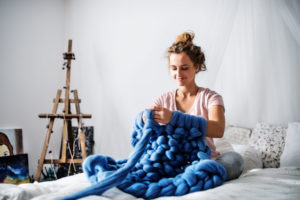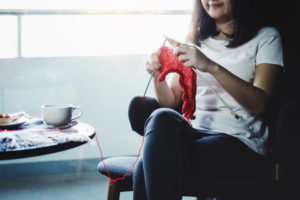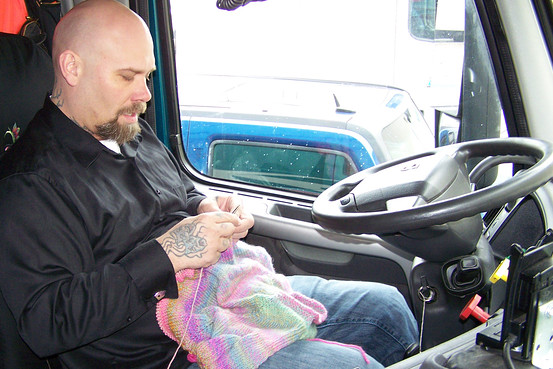Making your craft area efficient and beautiful using the Marie Kondo Technique
By Kathryn Vercillo
Marie Kondo’s KonMari method of decluttering has taken the world by storm. Whether or not you like her books and Netflix show, there’s something to be learned from her approach. Even if it doesn’t suit you completely, you can take away a few tips for creating a more organized craft space. The easier it is to see and access your craft supplies, the simpler and more inspiring it is to get to work.
Start with a Fresh Look at the Space
In her Netflix show, Marie Kondo always starts by giving a silent blessing to the house that she’s going to help organize. You can take a cue from this by giving a bit of pause before you dig into decluttering your craft space. You can use this pause to:
- Set an intention or goal
- Say a prayer or mantra
- Get grounded and centered
- Give gratitude to the space that you have
- Mentally prepare for the task at hand
You might also just take a moment to drink in your surroundings and see the space anew.
Pile All of Your Supplies in One Place
Marie Kondo divides the home into different sections (such as clothes and books) and asks people to tackle one section at a time. You will be tackling your crafts. The first order of business is to bring every single one of your craft supplies out into the same space. This is how you get a true sense of what you have and how it all makes you feel.
Get out your yarn, crochet hooks, knitting needles, fabric, zippers, stitch markers … all of the things that you use for crafting. You might want to put each one in a pile of its own (yarn with yarn, hooks with hooks) and you might even want to further break that down to see all of your bulky yarn in one pile, lightweight yarn in another, etc. If at all possible, though, keep all of the supplies in one room so that you can see them all together. This may seem daunting, but it’s a key part of the Marie Kondo KonMari method of decluttering.
Tip: Don’t forget your WIPs when you declutter. It’s time to prep them for finishing, frog them, or get rid of them as is.
 Find What Sparks Joy
Find What Sparks Joy
Marie Kondo’s approach is to go through each item one by one, holding it in your hand, and asking yourself, “does this spark joy?” If you get a zingy feeling of joy, then you should keep the item. Otherwise, you should get rid of the item.
People definitely get hung up on this part of the decluttering process. Our minds love to justify all sorts of reasons to hang on to something even if it doesn’t give us joy. We see the practicality, the money spent, the potential uses, and we don’t want to just give it away. However, life is short, so why should you work with any material that doesn’t spark joy? Try to stay true to this rule of the decluttering process.
Tip: The “spark joy” approach is really helpful when it comes to WIPs. If it doesn’t spark joy, let the project go. Give your time and energy to projects that energize you.
Let Go with Gratitude
When you find an item that doesn’t spark joy, it’s time to let it go. Before you do, pause for a moment to thank the item. Practice gratitude for the role it has played in your life. For example, you might remember that you bought a particular yarn for a project that you didn’t ever finish, and it’s time to let that yarn go, but you can be thankful for the inspiration you had at the time and the projects that took its place.
After saying goodbye, it’s time to remove the item from your house. You can donate craft supplies to various organizations including churches, schools, art programs, and nursing homes. If there is someone in your life who crafts, gift some items to them. The better you feel about where those supplies are going, the easier it will be to get them out of your own space.
Organize the Remaining Items
Once you are left with only the items that spark joy for you, it’s time to organize those. Marie Kondo has specific methods for folding clothes. She doesn’t have the same tips for craft supplies. However, the gist of her organizing method can work for you. With clothes, each type of item is folded the same way (t-shirts are all folded the same, for example, and socks are put the same way, too.) They are put away with care, so that they last as long as possible. They are also set up in a way that makes them easy to access without disrupting the rest of the bunch. For example, instead of stacking towels, she rolls them, placing them end up in a basket so that you can easily grab one while the others stay in place.
You can apply these principles to organizing your craft space. There are so many different ways to organize yarn, crochet hooks, and other supplies. Find what works for you and make it happen. Remember that you don’t have to buy a bunch of pricey organizing containers in order to make your crafts space better. You can upcycle the supplies that you already have. Get creative while making your space easier to navigate.
 Decluttering Alternatives if Marie Kondo Doesn’t Work for You
Decluttering Alternatives if Marie Kondo Doesn’t Work for You
Of course, the Marie Kondo method of decluttering doesn’t work for everyone. Hopefully, you can pull some ideas from the method that work for you and put them to use. That said, there are some other great approaches to try instead:
1) Do you love it or do you use it? This helps make the “spark joy” problem a little bit easier to navigate. You might not feel a spark of joy for a particular tool but if you use it regularly when you craft then you may still want to keep it. Recently fashion guru Tim Gunn was quoted as saying he doesn’t buy into the Marie Kondo method. He gave the example of Roget’s Thesaurus, which doesn’t spark joy for him, but which he also wants to keep. He could use the love it/ use it alternative.
2) Everything fits in one container. Author and decluttering expert Dana White uses a method in which every space is a container. For example, the living room is a container, the bookcase in the living room is its own container, and each shelf on the bookcase may be its own container. Every container has a purpose, used only for that purpose, and every type of one item must fit in one container. For example, all of the books in the house must fit in that one bookcase in the living room. She empties out the bookcase, then starts putting back her favorite books first. Once the bookcase is full, it’s full. If she wants to save another book, she has to pull one out of the container to make room. There’s no adding containers. Similarly, you might put all of your yarn in three bins in one closet of the house; when the bins are full, you have to decide which yarn must go to make room to add more.
3) Decluttering by the Numbers. There are various decluttering methods that use a numbers game. For example, The Minimalists have a game in which you declutter one item on the first of the month, two on the second, three on the third, etc. It’s a game that’s fun and easy to do. In one month, you get rid of almost 500 items. Each day is really easy, though. That’s a great way to start getting rid of excess craft supplies. Another similar option is to declutter ten things per day every day for a month.
Decluttering isn’t just about getting rid of stuff. It’s about making sure that you love and use what you have, that the excess doesn’t overwhelm you, and that your setting inspires you to craft. Keep those things in mind as you organize your craft space.
Kathryn Vercillo is the author of several books on crochet health including Crochet Saved My Life. She publishes a monthly crochet newsletter through Patreon.











Recent Comments